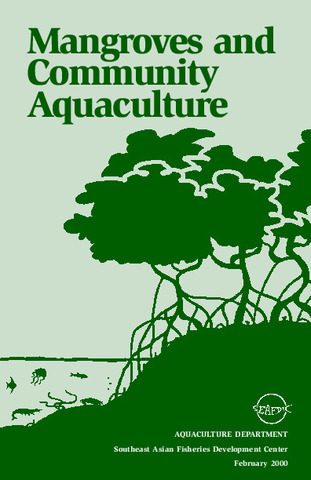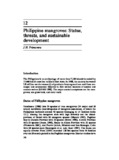Field guide to Philippine mangroves
- Global styles
- MLA
- Vancouver
- Elsevier - Harvard
- APA
- Help

Download URL
www.zsl.orgDate
2009Author
Page views
11,987AGROVOC keyword
Taxonomic term
Acrostichum 
Acrostichum aureum
Acrostichum speciosum
Aegiceras
Aegiceras corniculatum
Aegiceras floridum
Avicennia alba
Avicennia marina
Avicennia officinalis
Avicennia rumphiana
Brownlowia
Brownlowia tersa
Bruguiera cylindrica
Bruguiera gymnorrhiza
Bruguiera parviflora
Bruguiera sexangula
Camptostemon philippinensis
Ceriops
Ceriops decandra
Ceriops tagal
Excoecaria agallocha
Heritiera littoralis
Lumnitzera
Lumnitzera littorea
Lumnitzera racemosa
Osbornia octodonta
Pemphis acidula
Rhizophora mucronata
Rhizophora stylosa
Scyphiphora hydrophylacea
Sonneratia
Sonneratia alba
Sonneratia caseolaris
Sonneratia ovata
Xylocarpus
Xylocarpus granatum
Xylocarpus moluccensis

Acrostichum aureum

Acrostichum speciosum

Aegiceras

Aegiceras corniculatum

Aegiceras floridum

Avicennia alba

Avicennia marina

Avicennia officinalis

Avicennia rumphiana

Brownlowia

Brownlowia tersa

Bruguiera cylindrica

Bruguiera gymnorrhiza

Bruguiera parviflora

Bruguiera sexangula

Camptostemon philippinensis

Ceriops

Ceriops decandra

Ceriops tagal

Excoecaria agallocha

Heritiera littoralis

Lumnitzera

Lumnitzera littorea

Lumnitzera racemosa

Osbornia octodonta

Pemphis acidula

Rhizophora mucronata

Rhizophora stylosa

Scyphiphora hydrophylacea

Sonneratia

Sonneratia alba

Sonneratia caseolaris

Sonneratia ovata

Xylocarpus

Xylocarpus granatum

Xylocarpus moluccensis

Metadata
Show full item record
Share
Description
Awareness of mangrove importance, particularly for coastal protection, has grown among the general public over the past several years. In turn, this has led to numerous planting initiatives by various groups. However, most of these programs did not yield positive results mainly due to lack of science-guided protocols, particularly on what species to grow under certain conditions.
This field guide is an attempt towards broader awareness and appreciation of the common mangroves found in the Philippines. It is based on the original material, “Field Guide to Philippine Mangroves,” developed with support from the Pew Fellows Program in Marine Conservation and SEAFDEC PREFACE Aquaculture Department, and published by the Zoological Society of London-Philippines.
Seeing the vitality of this field guide, Philippine Tropical Forest Conservation Foundation, Inc. (PTFCF) partnered with ZSL-Philippines and Foundation for Communication Initiatives (FOCI) in repackaging this field guide for distribution to groups and individuals keen on mangrove rehabilitation. Together with the “Community-based Mangrove Rehabilitation Training Manual” and posters, this hopes to increase prospects of success for mangrove rehabilitation efforts, particularly in areas hit by Super Typhoon Yolanda, the most destructive typhoon ever recorded in modern history
Suggested Citation
Primavera, J. H. (2009). Field guide to Philippine mangroves. Zoological Society of London-Philippines.
Type
BookCollections
- Books and Book Chapters [123]
Related items
Showing items related by title, author, creator and subject.
-
Mangroves and community aquaculture
Unknown author (Aquaculture Department, Southeast Asian Fisheries Development Center, 2000)Describes the efforts of AQD to raise mudcrab in pens in mangrove areas in Palawan and Aklan with the participation of local communities. -
Philippine mangroves: status, threats and sustainable development
The status of the Philippine mangroves is examined, the functions of mangrove areas are highlighted, the threats to mangrove resources are identified, and the prospects for sustainable use are discussed. The Philippines ... -
A review of mangrove rehabilitation in the Philippines: successes, failures and future prospects
From half a million hectares at the turn of the century, Philippine mangroves have declined to only 120,000 ha while fish/shrimp culture ponds have increased to 232,000 ha. Mangrove replanting programs have thus been ...





